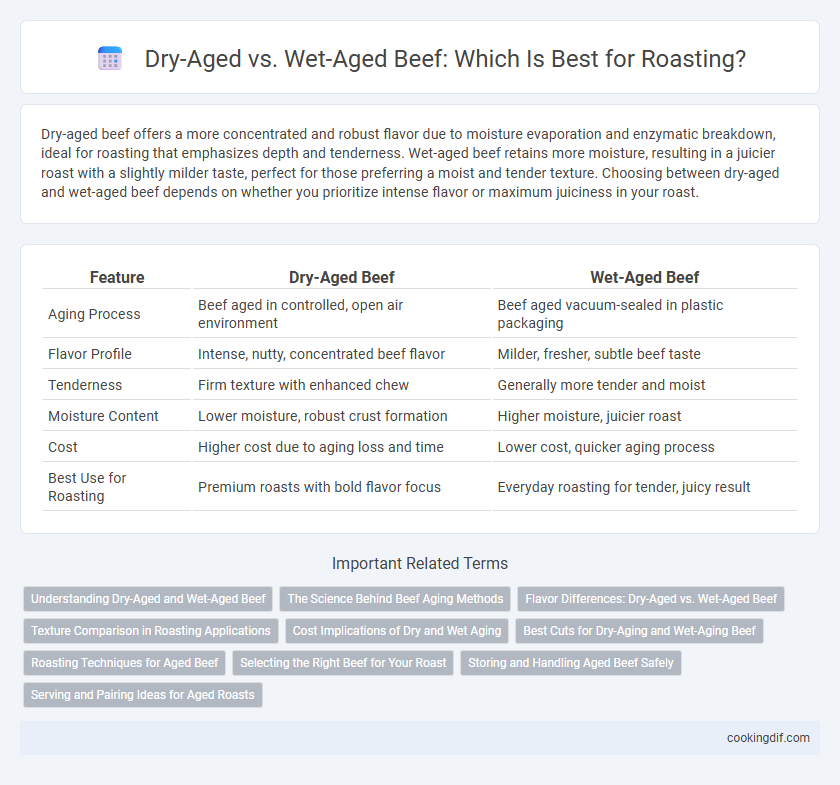Dry-aged beef offers a more concentrated and robust flavor due to moisture evaporation and enzymatic breakdown, ideal for roasting that emphasizes depth and tenderness. Wet-aged beef retains more moisture, resulting in a juicier roast with a slightly milder taste, perfect for those preferring a moist and tender texture. Choosing between dry-aged and wet-aged beef depends on whether you prioritize intense flavor or maximum juiciness in your roast.
Table of Comparison
| Feature | Dry-Aged Beef | Wet-Aged Beef |
|---|---|---|
| Aging Process | Beef aged in controlled, open air environment | Beef aged vacuum-sealed in plastic packaging |
| Flavor Profile | Intense, nutty, concentrated beef flavor | Milder, fresher, subtle beef taste |
| Tenderness | Firm texture with enhanced chew | Generally more tender and moist |
| Moisture Content | Lower moisture, robust crust formation | Higher moisture, juicier roast |
| Cost | Higher cost due to aging loss and time | Lower cost, quicker aging process |
| Best Use for Roasting | Premium roasts with bold flavor focus | Everyday roasting for tender, juicy result |
Understanding Dry-Aged and Wet-Aged Beef
Dry-aged beef undergoes controlled aging in a refrigerated environment for several weeks, which intensifies flavor and tenderizes the meat by allowing natural enzymes to break down muscle fibers. Wet-aged beef is vacuum-sealed and aged in its own juices for a shorter period, preserving moisture and resulting in a more mild taste. Understanding the differences in texture, flavor profile, and aging duration is crucial for selecting the best cut for roasting preferences.
The Science Behind Beef Aging Methods
Dry-aged beef undergoes a controlled dehydration process in temperature- and humidity-regulated environments, allowing natural enzymes to break down muscle fibers, intensifying flavor and improving tenderness through moisture evaporation. Wet-aged beef is vacuum-sealed in plastic, aging in its own juices, which preserves moisture but results in a milder flavor and less tender texture compared to dry-aging due to limited enzymatic breakdown. The science behind these methods centers on enzymatic proteolysis and moisture loss, where dry-aging enhances umami compounds and structural breakdown, while wet-aging primarily relies on anaerobic enzymatic activity without significant moisture reduction.
Flavor Differences: Dry-Aged vs. Wet-Aged Beef
Dry-aged beef develops a robust, concentrated flavor with nutty and earthy undertones due to moisture evaporation and enzymatic breakdown during aging. Wet-aged beef retains a milder, more metallic taste with higher tenderness since it is aged in vacuum-sealed packaging that preserves moisture. The choice between dry-aged and wet-aged beef significantly impacts the roast's depth of flavor and texture profile.
Texture Comparison in Roasting Applications
Dry-aged beef develops a firmer, more concentrated texture due to moisture evaporation and enzymatic breakdown, enhancing tenderness and flavor intensity during roasting. Wet-aged beef retains higher moisture content, resulting in a juicier but less complex texture, suitable for roasting methods requiring faster cook times. Texture differences significantly influence roast quality, with dry-aged cuts offering a more robust mouthfeel and wet-aged options providing a softer, more succulent bite.
Cost Implications of Dry and Wet Aging
Dry-aged beef typically commands higher prices due to the extended aging process and weight loss from moisture evaporation, increasing the cost per pound for roasting. Wet-aged beef is more cost-effective, as it ages in vacuum-sealed packaging with minimal weight loss, resulting in lower retail prices. Restaurants and consumers often weigh the premium of dry-aging against budget constraints, balancing flavor depth with cost considerations.
Best Cuts for Dry-Aging and Wet-Aging Beef
Prime rib and strip loin are the best cuts for dry-aging beef as their ample marbling and fat cover develop intense flavor and tender texture during the aging process. Wet-aging suits cuts like chuck and round, which benefit from moisture retention and result in a juicier roast with a milder taste. Choosing dry-aged ribeye or strip loin elevates roasting with rich umami notes, while wet-aged chuck provides economical juiciness ideal for slow-roasting methods.
Roasting Techniques for Aged Beef
Dry-aged beef enhances roasting by concentrating flavor and tenderizing muscle fibers through controlled dehydration and enzymatic processes. Wet-aged beef retains more moisture, resulting in a juicier roast that requires careful temperature management to prevent overcooking. Optimal roasting techniques for aged beef include searing at high heat to develop a caramelized crust, followed by slow roasting at lower temperatures to preserve tenderness and depth of flavor.
Selecting the Right Beef for Your Roast
Choosing between dry-aged and wet-aged beef for roasting significantly impacts flavor and texture; dry-aged beef delivers a more intense, nutty flavor with a firmer texture due to moisture evaporation during aging. Wet-aged beef, vacuum-sealed to retain moisture, offers a juicier and more tender roast with a fresher beef flavor, ideal for those preferring a milder taste. Selecting the right beef depends on desired taste profiles and cooking methods, with dry-aged suited for slow roasting to enhance complexity, while wet-aged performs well under high heat for quicker, tender results.
Storing and Handling Aged Beef Safely
Dry-aged beef requires controlled temperature and humidity, ideally between 34-38degF with 80-85% humidity, to prevent spoilage and promote flavor development during the aging process. Wet-aged beef should be stored in vacuum-sealed packaging at consistent refrigeration temperatures around 32-39degF to maintain safety and moisture retention. Proper handling involves minimizing exposure to air, using clean utensils, and ensuring prompt refrigeration after aging to reduce bacterial contamination risks.
Serving and Pairing Ideas for Aged Roasts
Dry-aged beef roasts offer a richer, more complex flavor profile that pairs exceptionally well with robust red wines like Cabernet Sauvignon or Syrah, enhancing the savory, umami notes developed during the aging process. Wet-aged beef roasts retain more moisture and tenderness, making them ideal for serving with lighter sides such as roasted root vegetables and creamy mashed potatoes, which complement the beef's subtle, juicy texture. Herbaceous or peppery sauces like chimichurri or a classic red wine reduction amplify the distinct characteristics of both dry-aged and wet-aged beef, creating a balanced and memorable roast dining experience.
Dry-Aged vs Wet-Aged Beef for roasting Infographic

 cookingdif.com
cookingdif.com